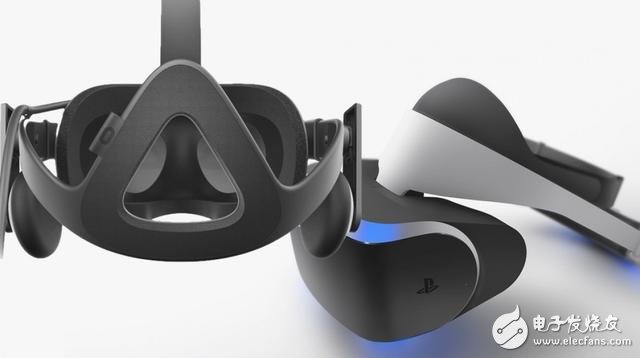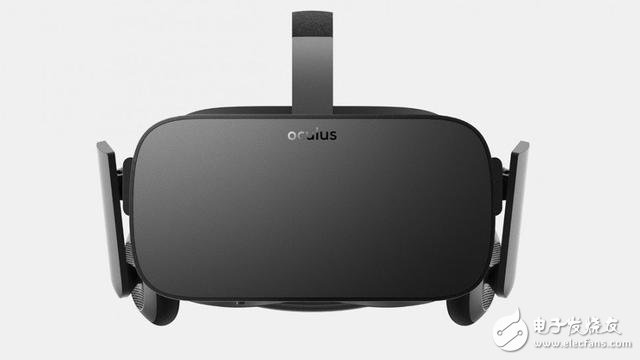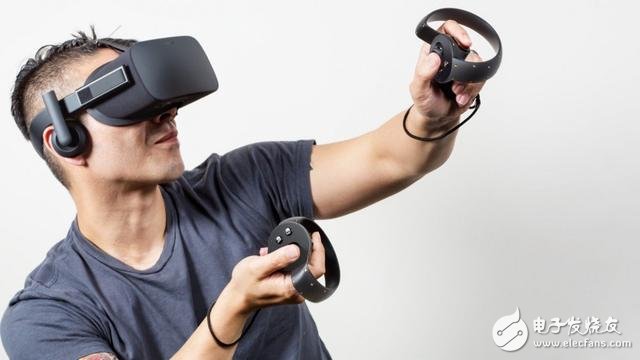Oculus Rift and PlayStaTIon VR (formerly codenamed Project Morpheus) are arguably the most popular virtual reality devices on the market, the former being Kickstarter and then being acquired by Facebook for $2 billion in 2014; on the other hand, PlayStaTIon VR comes from The technology giant Sony, especially in the field of games, is one of the well-deserved leaders.

For the user, who is better for Oculus Rift and PlayStaTIon VR? We can come and compare.
design

Many friends who often play games know that a few hours is a common occurrence for playing games, so light and comfortable is a very important aspect for such a helmet-mounted product. In terms of design, both Oculus Rift and PlayStaTIon VR value this aspect very much. Both look like a pair of glasses, which keep our face behind.
On the one hand, the consumer version of the Oculus Rift guarantees sufficient comfort, but does not disclose specific parameters, including the specific weight. From the prototype, the Oculus Rift continues to improve in ease of use and comfort, including a variety of interfaces and USB connections and additional vent design, so that players are not easy to appear in the game. The problem of sweating and being unable to discharge.
Sony has adopted another style that looks more like a fashion than a fashion, like the props in Star Trek. Sony has ingeniously integrated the goggles style into the design of the PlayStation VR, which means that only the eyes are blocked when the PlayStation VR is worn, and the nose and cheeks are exposed.
Sony showed the consumer retail version of PlayStation VR at GDC 2016. The experiencers said that they are comfortable to wear, and even those who wear glasses can use it directly, and various buttons can be easily touched.
screen

The PlayStation VR offers a 5.7-inch OLED display with 1920 x 1080p resolution, and each individual screen resolution for vertical splitting is 960 x 1080 pixels. Oculus has confirmed that the resolution of the Oculus Rift is 2160 × 1200 pixels, so the resolution of each split screen is basically divided by 2. At the same time, Sony is equipped with RGB sub-pixels on the PlayStation VR's 5.7-inch display to help eliminate jaggedness on the screen.
In order to reduce the wearer's visual fatigue, the screens of both products use a very high refresh rate, the refresh rate of the Oculus Rift developer version is 90Hz, and the refresh rate of the PlayStation VR is the highest in the virtual reality device, reaching 120Hz. Not only surpassed the Oculus Rift, but also surpassed another popular virtual reality device HTC Vive. If Oculus improves the Oculus Rift refresh rate in the retail version, we also think this is good news.
The latest generation of the Oculus Rift offers a 110 degree viewing range, while the PlayStation VR has a range of 100 degrees and the Oculus Rift wins slightly. When the PlayStation VR is worn, there will always be a small gap underneath, so in the case of special attention, there will be a little light leakage and you will see your feet, which is a bit strange.
hardware

All 3D images require large amounts of data processing, so both Oculus Rift and PlayStation VR require full synchronization and independent rendering of what each glasses see, keeping track of the user's head and Positioning in the physical space location.
If the frame rate is degraded, it will have an erroneous effect on the judgment of the target. Therefore, how to handle the signal sufficiently powerfully is also a very important factor. The PlayStation VR can additionally add processing to the video signal, and the built-in AMD graphics processor can further enhance the already processed 3D signal.
Sony still needs the PlayStation VR to connect to the PlayStation 4 host via USB or HDMI to complete the details that the PlayStation VR can't handle. In addition, the PlayStation VR also provides an output for the HDMI interface, so users can connect directly to an additional display to see if the user experience is distorted.
Thanks to the processing of data signals through the computer, Oculus Rift is more flexible in terms of system and platform. At present, the first step of Oculus Rift has started to cooperate with Microsoft to support Windows 10 platform, but there is still lack of support for Mac and Linux. .
The Oculus Rift's computer itself requires considerable performance and can perform 3D processing on 1080p/75fps signals. According to the Oculus Rift website, this hardware requirement basically belongs to the mid-end performance configuration of the PC. If converted to price, it is basically the same price as the Sony PlayStation 4 console. For example, the Intel i5 processor, 8GB of running memory, NVIDIA GTX970 or AMD 290 graphics card can meet the Oculus Rift configuration requirements.
The Kewupment Kit 2 version of the Oculus Rift uses a camera to track the user's position, and the Constellation tracking system has now reached a 360-degree level, and the sensor is installed in the environmental space to locate the user's position in space.
The Sony PlayStation VR also uses the camera for tracking, including head-up and tracking behind the body. At last year's GDC, Sony said that the number of LED trackers for PlayStation VR has increased from six to nine.
Sound and controller

Sound is the most overlooked, but also very important and subtle part of the virtual reality experience. Sony, as a technology giant with a number of well-known speakers and headphone products, naturally has a unique advantage in sound. The PlayStation VR provides a stereoscopic representation of the sound in the game through a dedicated 3D sound engine. If you bring headphones, including a helicopter at the top of the building or a stairway under your feet, you can bring a real live experience.
The consumer version of the Oculus Rift integrates a headphone system that also delivers a mixed audio experience. At last year's GDC 2015, Oculus said it would open the sound system's SDK, allowing developers to bring a true immersive audio experience to users with different content, and the sound can be rendered in multiple directions.
On the controller side, the PlayStation VR controller can be used to wave like a sword, and the Oculus Rift benefits from a collaboration with Microsoft, each of which will be equipped with an Xbox One wireless control handle. In addition, the Oculus Rift has its own dedicated controller that looks like a mini-sized handle that allows players to interact with each other in the virtual reality world. The handle of the Oculus Rift is sold as an optional accessory and the price has not been announced yet.
game
I am very happy that there are a lot of games that support PlayStation VR. The first release will be free of charge for The Playroom VR. This is a collection of multiple VR games, including "Monster Escape" and "Cat and Mouse". It is the gameplay of VR multiplayer. It is estimated that more than 50 PlayStation VR games will be launched in late 2016. Key games include "Eagle Eye" (Ubisoft Development), "EVE: Valkyrie", "Headmaster", "Rez Unlimited" (music game), "RIGS: Mechanized Combat Alliance" and so on. "Until Dawn" is developing a new version of VR, "Tekken 7", "Ace Combat 7", "Dead or Raw Beach Volleyball 3", "Final Fantasy 14" and other games have announced support for PlayStation VR. Many European, American and Japanese manufacturers have joined PlayStation VR development.
On the Oculus Rift side, 30 start-up games have just been released at GDC 2016, priced from $4.99 to $59.99. These include "Eve of Star Wars: Valkyrie", "Elite: Danger", "Car Racing Plan", "ADR1FT", "The Disappearance of Ethan Carter", "EVE: Valkyrie", and of course "Three-dimensional Pinball FX2" Traditional games and casual games.
Earlier, Oculus Rift expects to have more than 100 games for Rift helmets by the end of this year, including more than 20 platform-only games. And Unity and SteamVR all said they would be compatible with the Oculus development platform.
Price and release date
The price and release date of the two virtual reality devices are very close. The Oculus Rift is expected to begin accepting reservations in March of this year, with a booking price of $599 (approximately RMB 3,875) and will offer several free games and an Xbox One wireless controller.
Sony's PlayStation VR will be available in October this year, but the price is more approachable, as long as 399 US dollars (about 2580 yuan). At the same time, Sony will also launch a $499 package, in addition to the PlayStation VR, it will also provide headphones, PlayStation Camera, two mobile handles and a free digital version of PlayStation VR World and Playroom VR. download.
to sum up
In the comparison between PlayStation VR and Oculus Rift, there is no clear winner, and the two companies follow the same route for the time being. What the Oculus Rift needs to improve now is functionality, not form, and it needs to focus on improving the hardware and improving the design of the Oculus Rift. Sony has put a lot of effort into the design from the very beginning, so only a slight adjustment is needed in appearance.
Currently, Sony has a dedicated sound system for the PlayStation VR, so this has certain advantages over the Oculus Rift, which does not have much choice on sound devices. On the screen's most important parameters, the PlayStation VR's OLED screen has solved many problems at present.
Next up to the ecosystem, the Oculus Rift uses a PC as a gaming platform for better compatibility and flexibility, and is available to users without the need to purchase a console; PlayStation VR must rely on the PlayStation 4 console, although The audience is smaller, but more stable in terms of gameplay. In general, the difference between the two in the game experience is not big, and whether you choose PlayStation 4 or PC as the game platform, you have to look at the user's own choice.
After all, most consumers decide which product to buy, or refer to the platform that they already have, PC or PlayStation 4, and then we will see that Oculus, Sony and even HTC will launch various kinds of users. Various promotional strategies, and how to choose the user, have to get what you need.
A rice cooker or rice steamer is an automated kitchen appliance designed to boil or steam rice. It consists of a heat source, a cooking bowl, and a thermostat. The thermostat measures the temperature of the cooking bowl and controls the heat. Complex rice cookers may have many more sensors and other components, and may be multipurpose. Cooking rice has traditionally required constant attention to ensure the rice was cooked properly, and not burnt. Electric rice cookers automate the process by mechanically or electronically controlling heat and timing, thus freeing up a heating element on the cooking range that had to be otherwise occupied for rice cooking. Although the rice cooker does not necessarily speed up the cooking process, with an electric rice cooker the cook's involvement in cooking rice is reduced to simply measuring the rice, preparing the rice properly and using the correct amount of water. Once the rice cooker is set to cook, the rice will be cooked with no further attention.
Features:
For modern home rice cookers, the smallest single-person model cooks 1 rice cup (180 ml), whereas large models can cook 10 cups. Commercial models can cook 20 or more cups. As a possible source of confusion, model specifications and names may list either cooked or uncooked capacity. Rice roughly doubles in size during cooking; therefore, a 10 cup (uncooked) rice cooker can produce up to 20 cups of cooked rice. The prices vary greatly, depending on the capacity, features, materials used, and the country of origin.
The majority of modern electric rice cookers are equipped with a stay-warm or keep-warm feature, which keeps the rice at an optimal temperature for serving without over-cooking it. Some gas cookers also have electric stay-warm mechanism. However, the usefulness of this feature degrades over time, a microwave may be more energy efficient or better suited to reheat rice that will sit longer than four hours.
Some rice cookers use induction heating, with one or more induction heaters directly warming the pot. This can improve energy efficiency.
Most modern rice cookers use aluminium for the inner cooking bowl. There are some models that use stainless steel instead of aluminium. Various other materials, such as copper, pure carbon, ceramic, and diamond powder coating, may be used for higher heat conductivity or better taste.
The pressure-cooking models can raise the water's boiling point higher, e.g., from 100 °C at 1.0 atm up to about 110 °C at 1.4 atm, which speeds cooking. The pressure-cooking models can also be used in high altitude areas, where the boiling temperature is below 100 Celsius. Pressure cookers are also suitable for cooking brown rice (which contains oils and bran fiber that cook differently from pure white rice starch). Some pressure rice cookers have a varying pressure control mechanism (named the "dual-pressure" method) that creates repeated pressure/release cycles during the cooking.
There also exist mechanisms to collect and return the boiled over liquid to the inner rice bowl.
Many cookers now have microprocessor-controlled cooking cycles, which are often used to adjust for rice and cooking type.
Applications
Rice cookers are typically used for the preparation of plain or lightly seasoned rice. Each rice cooker model may be optimized to cook a certain type of rice best. For example, most Japanese rice cookers are optimized for cooking Japanese rice and may not be the best for other types of rice[citation needed], although cooking time can be lengthened simply by more water.
The typical method of cooking long grain rice is boil-and-strain and/or steaming method. The absorption method used in Japanese rice cookers will produce slightly different texture and taste, usually stickier rice.
Brown rice generally needs longer cooking times than white rice, unless it is broken or flourblasted (which perforates the bran).
Different varieties of rice need different cooking times, depending on their grain size, grain shape, and grain composition. There are three main types of Asian rice: Oryza sativa subsp. indica, i.e., Indian rice (long grain rice, e.g., basmati rice and Thai jasmine rice), O. sativa subsp. javanica, i.e., Java rice (large grain rice) and O. sativa subsp. japonica, i.e., Japanese rice (medium grain rice, e.g., Calrose rice, short grain rice, e.g., most Japanese rice and risotto rice).
African rice, Oryza glaberrima, is an entirely separate species, but can be cooked in the same way. Zizania is not even in the same genus, although it is often called a rice (or "water oats"); it, too, can also be cooked in a rice cooker.
A rice cooker can be used to cook many boiled or steamed granular foods, such as pot barley, bulgar wheat, and dal. Provided the ingredients have similar cooking times, a rice cooker can cook mixtures such as khichdi. Some rice cookers can be used as automated couscoussiers, cooking couscous and a stew simultaneously.
Rice Cooker
Rice Cooker,Drum Rice Cooker,Deluxe Rice Cooker,Straight Rice Cooker
Guangzhou Taipeng Electrical Appliances Technology CO., LTD. , https://www.kettles.pl